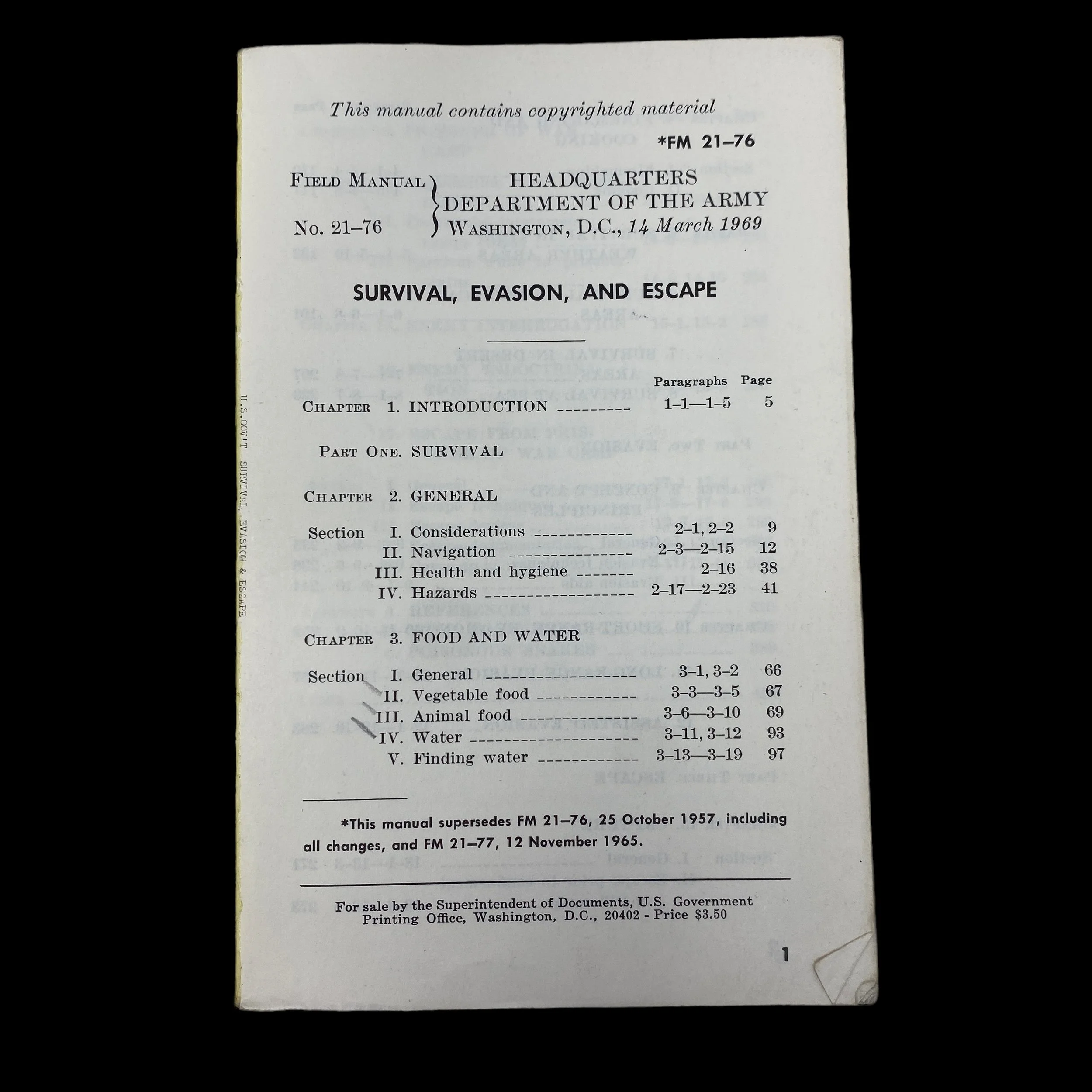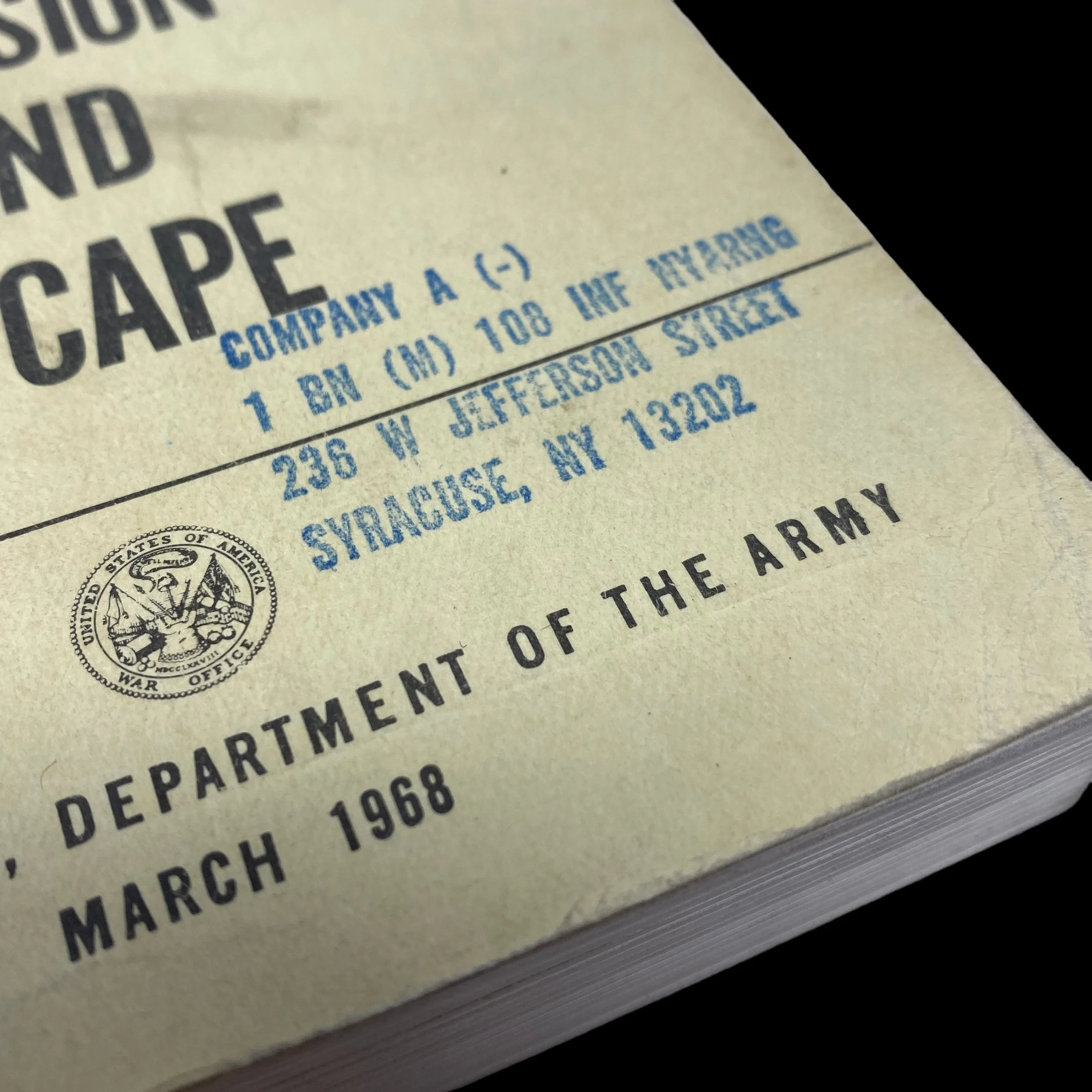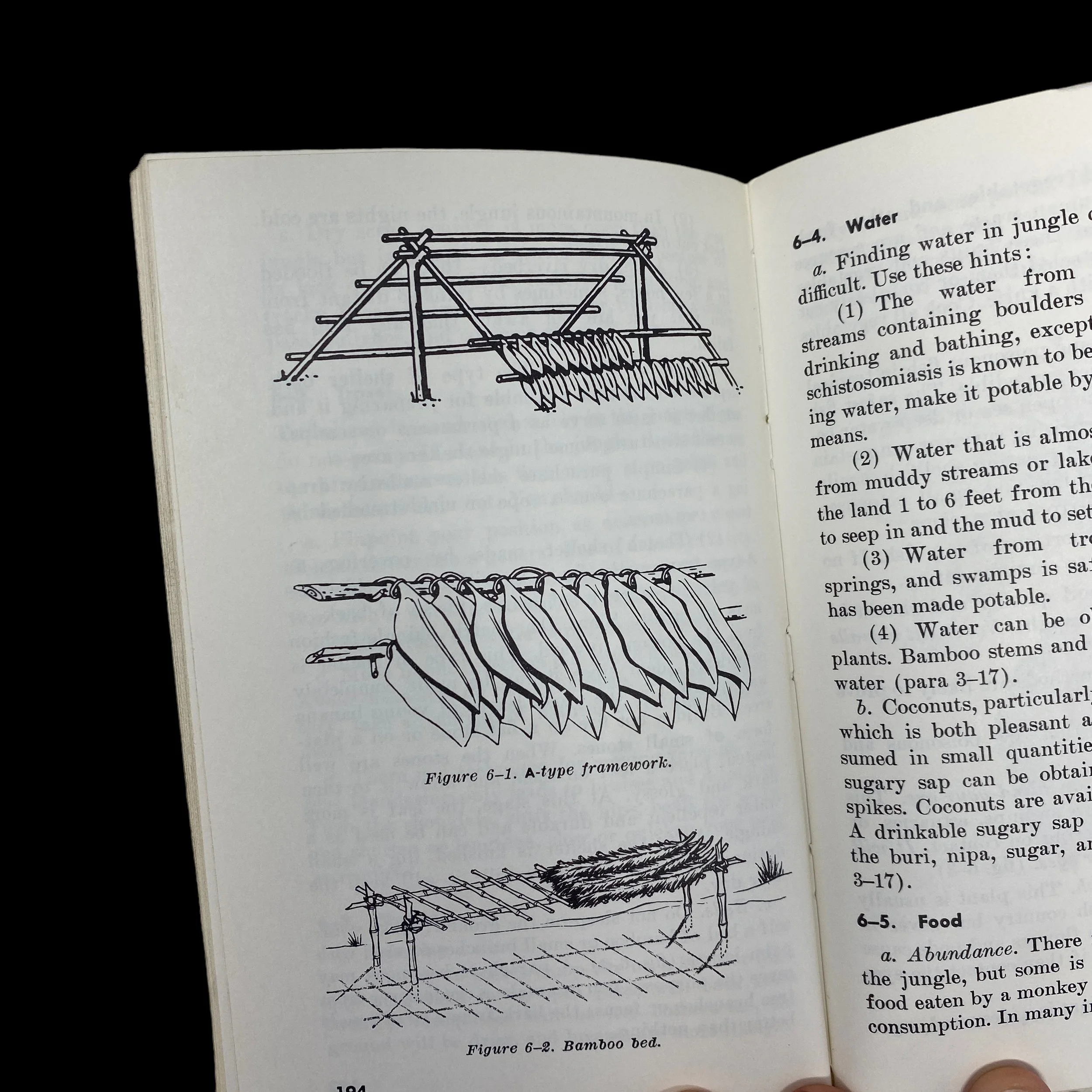VERY DETAILED! 1968 Vietnam War 108TH INFANTRY "SURVIVAL - EVASION - AND ESCAPE" (evasion techniques, evasion aids, long rand evasion, assisted evasion, escape from a PW camp)


































VERY DETAILED! 1968 Vietnam War 108TH INFANTRY "SURVIVAL - EVASION - AND ESCAPE" (evasion techniques, evasion aids, long rand evasion, assisted evasion, escape from a PW camp)
Comes with a hand-signed C.O.A.
This original and museum-grade Vietnam War artifact is one of the most extensively produced informational field manuals regarding “SURVIVAL - EVASION - AND ESCAPE”.
Dated March 1968 this manual was specially produced by the HEADQUARTER DEPARTMENT OF THE ARMY - WASHINGTON D.C. 1968. What makes this rare is that the front of this manual contains the original Vietnam War era stamp linking this manual to COMPANY A - 1ST BATTALION - 108TH INFANTRY.
This SURVIVAL - EVASION - AND ESCAPE manual was specially made to contain the most updated information and the latest techniques to be used in the Vietnam War.
This CAMOUFLAGE manual extensively details: navigation, constellations, hazards, finding water/food, fire making, survival in tropical areas, survival at sea, evasion techniques, evasion aids, long rand evasion, assisted evasion, escape from a PW camp, enemy interrogation, escape techniques, etc.
The Vietnam War, spanning from 1955 to 1975, was a complex and grueling conflict that required soldiers to navigate hostile terrains and evade enemy forces. Survival, Evasion, and Escape (SERE) became a critical aspect of military training during this era.
Navigation in Unfamiliar Terrain:
Navigating the dense jungles and unfamiliar terrains of Vietnam presented a significant challenge for American soldiers. SERE training emphasized the use of natural navigation cues such as constellations, terrain features, and indigenous flora. Soldiers were taught to identify prominent stars to determine direction during night operations. For example, the Big Dipper's orientation helped in locating the North Star, aiding navigation in the absence of traditional compasses.
Evasion in Hazardous Environments:
The Vietnam War landscape was rife with hazards, ranging from deadly wildlife to booby traps set by the Viet Cong. SERE training prepared soldiers to identify potential dangers and minimize risks. For instance, recognizing venomous snakes, avoiding contaminated water sources, and being cautious of hidden traps played a crucial role in the evasion phase.
Finding Water and Food Sources:
Survival in the dense jungles of Vietnam required soldiers to be resourceful in finding water and food. SERE training taught techniques such as identifying edible plants, purifying water through makeshift filters, and employing basic trapping methods for catching small game. These skills were invaluable for soldiers evading enemy forces in the wild.
Fire Making in Challenging Environments:
Mastering the art of fire making was crucial for survival in the Vietnam War's tropical environment. SERE training provided soldiers with the knowledge of gathering and preparing dry materials, using fire starter kits, and choosing suitable locations for campfires. The ability to build a fire discreetly was essential for warmth, cooking, and signaling without revealing one's position to the enemy.
Survival in Tropical Areas:
The harsh tropical conditions in Vietnam demanded specialized survival skills. SERE training addressed the challenges posed by high humidity, intense heat, and unpredictable weather patterns. Soldiers were taught to create improvised shelters, use available resources for insulation, and adapt to the demanding environment to increase their chances of survival.
Survival at Sea:
For soldiers engaged in maritime operations or downed pilots forced to eject over water, SERE training included techniques for survival at sea. This encompassed skills such as constructing rafts, signaling for rescue, and navigating using celestial bodies. Knowing how to procure food and water from the ocean and protect against exposure were vital aspects of maritime survival.
Evasion Techniques and Aids:
Evasion during the Vietnam War required soldiers to employ various techniques to avoid detection by enemy forces. SERE training emphasized the importance of stealth, camouflage, and understanding the enemy's tactics. Soldiers were taught to exploit the natural environment for cover and concealment, making it difficult for the enemy to track their movements.
Long-Range Evasion:
Long-range evasion involved moving stealthily through enemy territory for extended periods. SERE training equipped soldiers with the knowledge of evading detection, navigating vast distances, and surviving with minimal resources. This aspect was particularly relevant for special operations forces and reconnaissance teams operating deep behind enemy lines.
Assisted Evasion:
In some instances, soldiers required assistance during evasion. SERE training covered protocols for requesting and receiving support, including communication techniques to avoid enemy interception. Coordination with friendly forces, such as rescue teams or allied guerrilla fighters, played a crucial role in successful assisted evasion.
Escape from POW Camps:
The unfortunate reality of war in Vietnam was the capture of American soldiers as prisoners of war (POWs). SERE training included techniques for escaping captivity, focusing on exploiting weaknesses in enemy prison facilities, creating diversions, and utilizing available tools for self-defense. Successful escapes required a combination of physical prowess, mental resilience, and strategic planning.
Enemy Interrogation Resistance:
Soldiers facing capture knew they might endure harsh interrogation. SERE training aimed to prepare them for such situations, teaching resistance techniques, methods to mislead captors, and ways to withstand physical and psychological pressure. Understanding enemy interrogation tactics enabled soldiers to maintain critical information security.
Escape Techniques:
The final phase of SERE training, escape, emphasized regaining freedom once captured. This involved exploiting opportunities during transport, navigating away from enemy forces, and seeking refuge with friendly elements. Escape techniques were tailored to the unique challenges presented by the Vietnam War's dynamic and unpredictable battlefield.
Survival, Evasion, and Escape were paramount skills for American forces during the Vietnam War, where the dense jungles, hazardous conditions, and persistent threat of capture made these techniques essential. SERE training equipped soldiers with a diverse set of skills, ranging from navigation and survival in challenging environments to evasion tactics and escape techniques. The ability to adapt, improvise, and overcome the diverse challenges of the Vietnam War landscape was crucial for the success and survival of American military personnel during this tumultuous period.